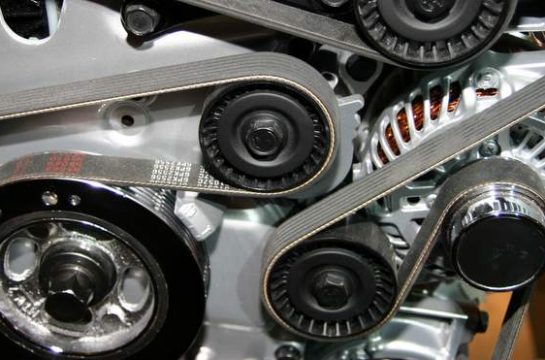Today, most vehicles have one ribbed serpentine belt responsible for running all of the accessory components. This belt can be tensioned automatically or manually. Automatically tensioned serpentine belts are the most common and are kept at the proper tension with a tensioner comprised of a housing unit, spring, idler pulley with bearing, pivot, and mounting bolts. The automatic tensioner is designed to apply constant accurate tension to the belt. Manually tensioned serpentine belts are less common and have a mechanical adjustment comprised of threaded bolts, nuts, and adjustable slotted brackets.
Serpentine belts are made of high quality reinforced rubber. The lifespan of the serpentine belt depends mostly on the material it is made of. Older Neoprene rubber belts generally last about 50,000 miles, while newer belts made from Ethylene Propylene Diene Monomer (EPDM) rubber will last up to 100,000 miles.
Serpentine belts can fail in a few different ways. The most serious failure is when the serpentine belt breaks completely. This is usually the result of a belt in poor condition, or a problem with one of the accessory components being driven by the belt. A failed bearing in a pulley being driven by the serpentine belt will also cause the belt to break.
Some possible consequences of a serpentine belt breaking while driving include: the illumination of warning lights on your dashboard, difficulty steering the vehicle, engine overheating, and the battery going dead in a few miles because the alternator would not be charging. A broken serpentine belt will have numerous negative effects on your engine and can potentially be dangerous.
There are many indicators that your serpentine belt on your Asian Import, may need to be replaced. Deep cracking in the ribs and spine of the serpentine belt is a common indicator your belt is due to be replaced. A noisy belt is also indicative of a problem. Your serpentine belt can also become contaminated with oil or coolant due to other issues with the vehicle. These contaminants will reduce the life of the belt and contribute to irregular noises.
An aged belt on your Asian Import may become shiny or glazed in appearance. It may also begin to harden and lose some of its flexibility. An aged belt made of EPDM rubber may also show excessive wear in the ribs and valleys of the belt which can lead to slippage. An EPDM belt will not crack like traditional Neoprene rubber belts. Instead, it will wear and lose rubber similar to the way a tire wears out. EPDM belts need to have the rib valleys inspected with a belt wear gauge. All of these potential issues can be easily detected during a routine inspection at Automotive Instincts in Woodland Hills and Northridge.
Take the time to have Automotive Instincts inspect your serpentine belt, belt tensioner, and the accessory components driven by your serpentine belt every time you take your vehicle in for routine services. Serpentine belts typically give ample visual warning of impending failure. Driving your vehicle with an old and worn out belt is a disaster waiting to happen. Drive with peace of mind by having your serpentine belt inspected and replaced when necessary at Automotive Instincts.
Make an appointment today at Automotive Instincts.
Automotive Instincts
19831 Ventura Blvd
Woodland Hills, CA 91367
(818)883-4172
www.automotiveinstincts.com
#trust
#automotiveinstincts
#wecare
#honda
#toyota
#nissan
#mazda
#lexus
#serpentinebelt
#service
#woodlandhills
#nextdoor.com
#infiniti
#acura
#aaa
#yelp
#google

